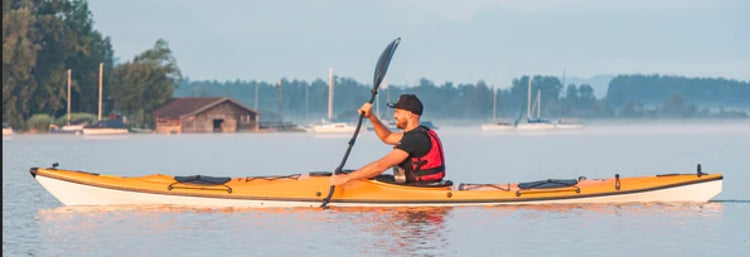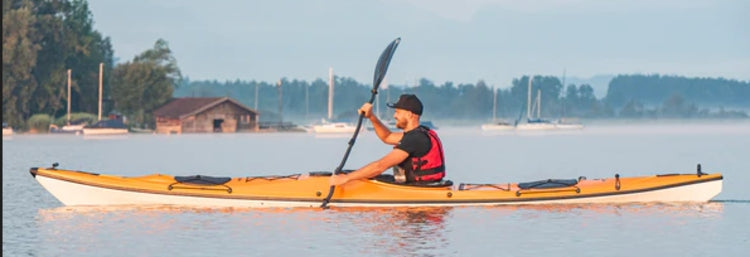One of the best parts about kayaking is the many different styles of paddling you can partake in. From relaxation to fishing, racing, exploration, and physical fitness, every paddler has their own personal goals. Even better, there’s a specific type of kayak that caters to these different activities.
Today, we’re going to focus on some of the most exciting paddling adventures; day touring and expedition touring. In case you’re unfamiliar, day touring and expedition kayaks have a variety of subtle differences, and we’re going to explore these below.
What’s the Difference Between Day Touring and Expedition Touring Kayaks?
At first glance, these kayaks may look a little similar. Both are longer than recreational boats, narrower for speed, and designed with performance in mind. But the differences lie in the details; the length, hull design, storage, weight, and even cockpit style. Here’s a quick overview
Day Touring Kayaks are built for shorter trips, typically anywhere from a few hours to a full day. They’re generally between 3.5 and 4.5 metres long, with good stability, responsive turning, and enough storage for snacks, safety gear, and maybe an overnight bag. They give you a taste of touring performance without committing to a full expedition-style setup.
Expedition Touring Kayaks are the big guns of the paddling world. Stretching from 5 metres and beyond, they’re sleek, fast, and made for covering long distances with efficiency. With multiple storage hatches, bulkheads, and a hull optimised for tracking (that’s staying in a straight line), they’re the choice for multi-day adventures where you need to carry camping gear, food, and supplies.
Think of it this way: if a day touring kayak is your reliable day pack, an expedition kayak is your fully loaded hiking backpack, complete with tent, stove, and all the gear you need to live out of it.
Length and Speed
Length is the first big giveaway when you’re comparing these kayaks. Day tourers are shorter, which means they’re easier to manoeuvre and turn. As a result, they’re generally a great option for rivers, inlets, and bays where you might be weaving between obstacles or hugging the shoreline.
Expedition kayaks, on the other hand, are long and built to glide. Every stroke carries you further, and while they may not spin on a dime, they’ll chew through kilometres with ease. So, if you’ve got visions of multi-day paddling a river, through the Whitsundays or long coastal journeys, this extra efficiency is exactly what you’ll want.

Coming in at a size of 5.18m, the Prijon Grizzly HTP is a spacious kayak for the big tour or the big paddler.
Storage Capabilities
Storage is another key difference. A day touring kayak will often come with one or two hatches, enough to stash lunch, water, a dry bag, and maybe some lightweight camping gear. But they’re not designed to carry a week’s worth of supplies.
Expedition kayaks are basically floating caravans. Multiple hatches, watertight bulkheads, and lash points for deck bags give you room both on and in the kayak to pack tents, sleeping bags, cookers, clothing, and food. Some paddlers even manage to bring along a few luxuries—think folding camp chairs or an extra bottle of red—because the boat does the heavy lifting.

The Hurricane USA Sojourn 146 - Day Touring Excellence at its Finest
Comfort and Cockpit Design
When you’re sitting in your kayak for hours at a time, comfort is more essential than a luxury. Day touring kayaks usually feature slightly larger cockpits, which makes them easier to get in and out of. That’s a plus if you’re hopping in and out during a day on the water.
Expedition kayaks generally tend to have a snugger fit. This gives you better boat control, especially in rough conditions and challenging open water environments, but it also means you’ll need to be comfortable with a more enclosed feel. Adjustable seating, supportive backrests, and ergonomic outfitting all become crucial for those longer paddling adventures. The use of a half or full skirt is often recommended too, which is designed to keep you warm, and water out of the cockpit in rougher conditions.
Performance on the Water
Here’s where things get really interesting: performance. While storage and length are easy to spot, performance differences are what you’ll actually feel once you’re on the water.
Efficiency and Endurance
Expedition kayaks are designed to cover distance. Their narrow, streamlined hulls reduce drag, so each stroke goes further. But with that comes the need for better paddling technique; engaging your torso, keeping strokes efficient, and pacing yourself for endurance. Day touring kayaks are more forgiving here; you can take breaks, drift, and still keep things under control.
Rudders and Skegs
Many touring boats feature either a rudder or skeg to assist with tracking. Expedition kayaks almost always have one or both, and they’re essential in windy conditions or strong currents. A skeg (a drop-down fin) helps hold a straight course, while a rudder (controlled by your feet) makes steering easier when your boat is fully loaded, especially if you’re paddling in wind, a tidal flow or a current.
Day tourers may not need this level of control on calmer waterways, but once you’re in open water with gear onboard, these tools become performance game-changers.
Edging and Manoeuvrability
Manoeuvrability is one area where day touring kayaks really shine. They edge easily, respond quickly, and make exploring shorelines or weaving through river bends fun and playful.
Expedition kayaks, thanks to their length and hull shape, aren’t quite as nimble. But once you learn to edge your kayak (that subtle lean to help carve turns), you’ll unlock a whole new level of control. Of course, you will absolutely have to practice this technique in calm water before heading into bigger conditions. Don’t attempt it in challenging waters without experience, unless you’re trying to capsize! However, once mastered, edging turns a seemingly big expedition kayak into a surprisingly agile craft.
Stability
Day touring kayaks are typically designed and built with a focus on primary stability, meaning they feel steady and solid when you first get in. Expedition kayaks lean more toward secondary stability. What we’re referring to here is that they shine when tipped slightly on edge or in choppy seas. It will take a little getting used to, but in more difficult conditions, that secondary stability really gives you confidence to handle waves without capsizing.
Pick Up a Brand-New Kayak at PaddleZone
Alright, enough theory. Let’s talk about paddlecrafts. Here are some fantastic options you’ll find at PaddleZone that highlight the best of both worlds. Be sure to follow the links for a detailed description of each model, as well as reviews, videos, and more!
Point 65 Sweden Mercury GTX Solo
Welcome to the new generation of modular kayaks.
With a setup as easy as 1, 2, 3, this follows the success of Point 65’s modular recreational kayaks. This time, it's the touring version. Available in orange, blue andred, the Point 65 Mercury GTX 14/18 is a high-performance, stable, decked modular touring kayak with a large cockpit with which to explore and then take back home in the boot of your car.

Prijon PriLite Neptun
Prijon has updated their well-known Neptun Laminate kayak with the all new PriLite version for 2025. The result is a high-performance sea kayak designed for medium to larger paddlers seeking excitement and agility on the ocean, while also offering enough storage for multi-day expeditions.

The modern skeg only design provides stability and manoeuvrability for ocean surfing, but is also suitable for inland lakes and rivers. The lightweight PriLite hull allows for effortless transportation.
Hurricane Sojourn 146 Rudder Ready
The Sojourn 146 offers excellent speed and tracking while also navigating tight turns with ease. At 4.45m long, the Sojourn is the perfect day tourer.
This day-touring design carves and edges like a much longer kayak, but balances that agility with a 61cm beam for excellent stability from the moment you hit the water.
Fore and aft compartments offer ample storage space for camping trips, while solid ABS bulkheads provide confidence for paddling in big water.

Scorpio Swordfish Series II
The Swordfish Double is a brilliant touring kayak for day and even overnight excursions, as well as fishing, photographing, and simply, it's great for having fun. It’s really the perfect tandem kayak for everyone; from beginners to expert paddlers. Available in multiple colours, it looks great, as well as delivers on handling, comfort and affordability.

Overall, it's hard to go wrong with Swordfish, whether you need a paddle craft for your local clubs, an outfitter, your family, or as a tour guide.
Which One is Right for You?
So, should you go for a day touring kayak or take the plunge into expedition territory? It comes down to where and for how long you plan to paddle.
-
If your adventures are mostly short trips, weekend outings, or explorations of local waterways, a day touring kayak will give you the perfect mix of comfort and fun without being overwhelming.
-
If you dream of packing up and heading off-grid, tackling long coastlines, or paddling from campsite to campsite, an expedition kayak will be worth every extra centimetre of length.
There’s no wrong choice—it’s about matching the boat to your adventure level. And if you’re like many paddlers, you may eventually end up with one of each. After all, can you ever really have too many kayaks?




